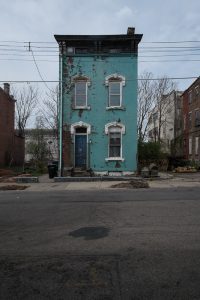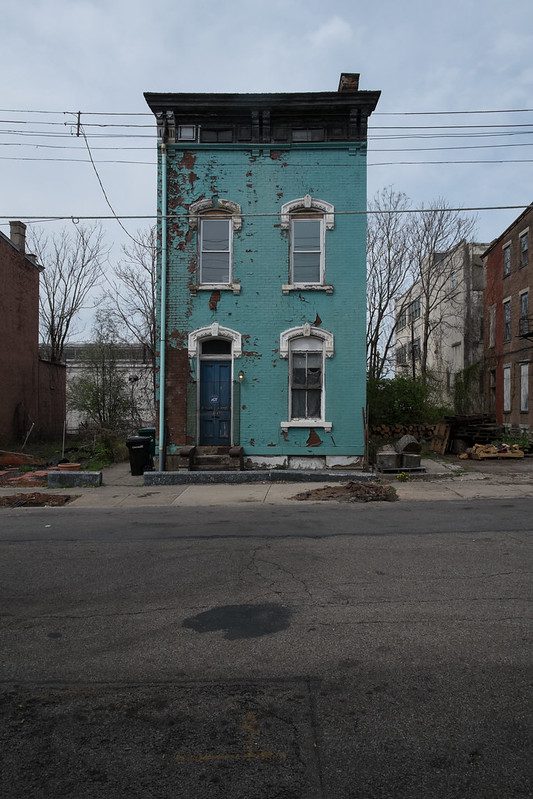
A house in Cincinnati’s West End neighborhood, 2019. Photo by Flickr user Paul Sableman, CC BY 2.0
Poor people must not like Starbucks. I wonder about that each time I drive my borrowed hooptie through and around Cincinnati’s West End neighborhood.
Development is nigh. It’s in the form of cookie-cutter, peanut butter–brown brick condominiums and multi-unit apartments. There are rumors that a recreation center is coming.
I’ve been joking that West End residents will now probably get a Starbucks since company’s coming. The cops will probably morph into shiny, happy people so as to make the new residents feel safe and sane for movin’ on down like the Jeffersons.
But will long-time residents still be able to buy bags of synthetic hair for their weaves, minutes for their cell phones, and chicken, biscuits and sugary sweet beverages for their children?
I feel a whitewash coming on.
Right now, plans call for the Cincinnati Metropolitan Housing Authority (CMHA) to replace some of its subsidized housing with more of the same and to mix that with market-rate housing ranging in price from $150,000 to $240,000. This smells like court-ordered busing.
And like busing, this government-mandated mixer is sure to keep residents separate but unequal; the CMHA housing units will not be near the market-rate housing. So, although folks of disparate income levels will be living together, they won’t really be living together.
They’ll just kinda know the other exists, which is pretty much already how life is in Cincinnati.
Before and since last April 7, when former Cincinnati police officer Stephen Roach shot and killed 19-year-old Timothy Thomas in a Republic Street alcove in Over-the-Rhine, we’ve proven we can’t all just get along.
We are perpetually judging each other and ourselves by our zip codes.
The corridors of northern and eastern suburbs are exploding in development. These outlying communities have become gated, strip-malled homogeneous communities unto themselves. Developers turn soil over and out sprout Blockbusters, pricey private day-care, and gourmet eateries to help maintain the lifestyles of the rich and mundane.
With their uber-markets, high-post specialty boutiques, and Abercrombie & Fitch dress codes, there’s no reason for residents to ever leave these posh communities, and who’d blame them? The Stepford Moms and Dads have rightfully divorced themselves from “the city” and its problems, driving in only to work and getting the hell out by sundown.
Meanwhile, with the demolition of 5,000 to 10,000 homes, there’s a 90 percent decrease in the number of available low-income West End housing units, according to leaflets distributed by West End activist Brian Garry during the March for Justice that marked the one-year anniversary of Thomas’s death.
Surely one certain and quick way to make better and more diverse schools is to make better and more diverse neighborhoods. But in the process, five West End schools have closed. The familiar infrastructure has been snatched away, and an alien one predisposed to the comfort levels of newcomers is on its way.
Further, with all we’ve weathered and the fire next time sure to come, cutting and pasting pre-fab housing after all these years seems now a bit suspicious. It says, we don’t trust you to live together on your own so we’ll force it if we must.
The old Regal Theater has been an empty and crumbling eyesore for nearly a decade, and it may also be redeveloped. The last movie screened there was Demolition Man, starring Arnold Schwarzenegger and Wesley Snipes. How prophetic: A mixed-race flick with the word “demolition” in its title shown in a neighborhood soon to be overrun by Yuppies and apologetic Negroes moving in only after the city gives the high sign.
Forget that West End residents for years have had to take maybe two buses to see a movie or get groceries.
The Yuppies are coming! The Yuppies are coming! And they like their neighborhood theaters well-lit and within reasonable distance to their homes.
The West End is currently being bulldozed, rebuilt, overdeveloped and reconfigured. In the process, thousands of Section 8 dwellers have been “relocated.”
Run off, really.
I’ve been for months asking around and no one really seems to know what city developers did to transition these folks—many of whom have lived there for generations—into other, inconvenient, and spread-out neighborhoods.
Linn Street, the West End’s main tributary, is a long strip connecting to Central Parkway to the north and Eighth Street to the south. Along it are bodegas, hole-in-the-wall bars, an after-hours joint, junk food outlets, and a few fast food joints. It’s all the stuff that doesn’t really enhance a neighborhood and is usually the mainstay of poor white and black sections of a city. In between them are billboards advertising cigarettes, alcohol and hair care products.
Linn Street may soon turn into Harlem Midwest. That is, are we soon to see a Gap, Old Navy, and a TGI Friday’s where once there were fried chicken joints, hair salons, and check cashing stores?
I hope so. As long as the former doesn’t eclipse and squeeze out the latter. If so, then we’re just building a prettier ghetto. And we’ve got enough of those already.
They’re called suburbs.




Comments